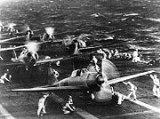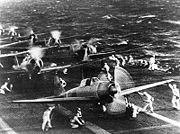
Pacific Ocean theater of World War II
Encyclopedia
The Pacific Ocean theatre was one of four major naval theatres of war of World War II
World War II
World War II, or the Second World War , was a global conflict lasting from 1939 to 1945, involving most of the world's nations—including all of the great powers—eventually forming two opposing military alliances: the Allies and the Axis...
, which pitted the forces of Japan
Empire of Japan
The Empire of Japan is the name of the state of Japan that existed from the Meiji Restoration on 3 January 1868 to the enactment of the post-World War II Constitution of...
against those of the United States
United States
The United States of America is a federal constitutional republic comprising fifty states and a federal district...
, the British Commonwealth, the Netherlands
Dutch East Indies
The Dutch East Indies was a Dutch colony that became modern Indonesia following World War II. It was formed from the nationalised colonies of the Dutch East India Company, which came under the administration of the Netherlands government in 1800....
and France.
The theater included most of the Pacific Ocean
Pacific Ocean
The Pacific Ocean is the largest of the Earth's oceanic divisions. It extends from the Arctic in the north to the Southern Ocean in the south, bounded by Asia and Australia in the west, and the Americas in the east.At 165.2 million square kilometres in area, this largest division of the World...
and its islands, excluding the Philippines
Philippines
The Philippines , officially known as the Republic of the Philippines , is a country in Southeast Asia in the western Pacific Ocean. To its north across the Luzon Strait lies Taiwan. West across the South China Sea sits Vietnam...
, Australia
Australia
Australia , officially the Commonwealth of Australia, is a country in the Southern Hemisphere comprising the mainland of the Australian continent, the island of Tasmania, and numerous smaller islands in the Indian and Pacific Oceans. It is the world's sixth-largest country by total area...
, the Netherlands East Indies
Dutch East Indies
The Dutch East Indies was a Dutch colony that became modern Indonesia following World War II. It was formed from the nationalised colonies of the Dutch East India Company, which came under the administration of the Netherlands government in 1800....
, the Territory of New Guinea
New Guinea
New Guinea is the world's second largest island, after Greenland, covering a land area of 786,000 km2. Located in the southwest Pacific Ocean, it lies geographically to the east of the Malay Archipelago, with which it is sometimes included as part of a greater Indo-Australian Archipelago...
(including the Bismarck Archipelago
Bismarck Archipelago
The Bismarck Archipelago is a group of islands off the northeastern coast of New Guinea in the western Pacific Ocean and is part of the Islands Region of Papua New Guinea.-History:...
) and the Solomon Islands
Solomon Islands
Solomon Islands is a sovereign state in Oceania, east of Papua New Guinea, consisting of nearly one thousand islands. It covers a land mass of . The capital, Honiara, is located on the island of Guadalcanal...
(which were part of the Southwest Pacific area.) The Pacific Ocean theater also excluded China
China
Chinese civilization may refer to:* China for more general discussion of the country.* Chinese culture* Greater China, the transnational community of ethnic Chinese.* History of China* Sinosphere, the area historically affected by Chinese culture...
and mainland Southeast Asia
Southeast Asia
Southeast Asia, South-East Asia, South East Asia or Southeastern Asia is a subregion of Asia, consisting of the countries that are geographically south of China, east of India, west of New Guinea and north of Australia. The region lies on the intersection of geological plates, with heavy seismic...
. It takes its name from 30 March 1942 when it became the major Allied
Allies of World War II
The Allies of World War II were the countries that opposed the Axis powers during the Second World War . Former Axis states contributing to the Allied victory are not considered Allied states...
command
Command (military formation)
A command in military terminology is an organisational unit that the individual in Military command has responsibility for. A Commander will normally be specifically appointed into the role in order to provide a legal framework for the authority bestowed...
in the theater, known simply as "Pacific Ocean Areas".
Leaders


Imperial Japanese Navy
The Imperial Japanese Navy was the navy of the Empire of Japan from 1869 until 1947, when it was dissolved following Japan's constitutional renunciation of the use of force as a means of settling international disputes...
was led by Admiral Isoroku Yamamoto
Isoroku Yamamoto
was a Japanese Naval Marshal General and the commander-in-chief of the Combined Fleet during World War II, a graduate of the Imperial Japanese Naval Academy and a student of Harvard University ....
, until he was killed in an attack by U.S. fighter planes in April 1943. Yamamoto was succeeded by Admiral Mineichi Koga
Mineichi Koga
- Notes :...
(1943–44) and Admiral Soemu Toyoda (1944–45).
Admiral, later Fleet Admiral Chester W. Nimitz commanded the vast majority of Allied naval forces in the Pacific Ocean during the period 1941–45. The Allied Pacific Ocean Areas (POA) command was formed in March 1942. The POA was further divided into the North, Central, and South Pacific Areas, with subordinate commanders. Nimitz retained direct control of the Central Pacific Area (CENPAC).
Major campaigns and battles
- Central Pacific Theater
- Attack on Pearl HarborAttack on Pearl HarborThe attack on Pearl Harbor was a surprise military strike conducted by the Imperial Japanese Navy against the United States naval base at Pearl Harbor, Hawaii, on the morning of December 7, 1941...
7 December 1941 - Battle of Wake IslandBattle of Wake IslandThe Battle of Wake Island began simultaneously with the Attack on Pearl Harbor and ended on 23 December 1941, with the surrender of the American forces to the Empire of Japan...
7–23 December 1941 - Doolittle RaidDoolittle RaidThe Doolittle Raid, on 18 April 1942, was the first air raid by the United States to strike the Japanese Home Islands during World War II. By demonstrating that Japan itself was vulnerable to American air attack, it provided a vital morale boost and opportunity for U.S. retaliation after the...
18 April 1942 - Battle of MidwayBattle of MidwayThe Battle of Midway is widely regarded as the most important naval battle of the Pacific Campaign of World War II. Between 4 and 7 June 1942, approximately one month after the Battle of the Coral Sea and six months after Japan's attack on Pearl Harbor, the United States Navy decisively defeated...
4–6 June 1942 - Gilbert and Marshall Islands campaignGilbert and Marshall Islands campaignIn the Pacific Theater of World War II, the Gilbert and Marshall Islands campaign, from November 1943 through February 1944, were key strategic operations of the United States Pacific Fleet and Marine Corps in the Central Pacific. The campaign was preceded by a raid on Makin Island by U.S...
1943–44- Makin Island raidMakin Island raidThe Makin Island Raid was an attack by the United States Marine Corps on Japanese military forces on Makin Island in the Pacific Ocean...
17–18 August 1942 - Battle of TarawaBattle of TarawaThe Battle of Tarawa, code named Operation Galvanic, was a battle in the Pacific Theater of World War II, largely fought from November 20 to November 23, 1943. It was the first American offensive in the critical central Pacific region....
20 November 1943 - Battle of KwajaleinBattle of KwajaleinThe Battle of Kwajalein was a battle of the Pacific campaign of World War II, fought from 31 January-3 February 1944, on Kwajalein Atoll in the Marshall Islands. Employing the hard-learned lessons of the battle of Tarawa, the United States launched a successful twin assault on the main islands of...
1 February 1944 - Battle of EniwetokBattle of Eniwetok-External links:* *...
17 February 1944
- Makin Island raid
- Attack on Truk IslandOperation HailstoneOperation Hailstone was a massive naval air and surface attack launched on February 17–18, 1944, during World War II by the United States Navy against the Japanese naval and air base at Truk in the Caroline Islands, a pre-war Japanese territory.-Background:Truk was a major Japanese logistical base...
17-18 February 1944 - Mariana and Palau Islands campaignMariana and Palau Islands campaignThe Mariana and Palau Islands campaign, also known as Operation Forager, was an offensive launched by United States forces against Imperial Japanese forces in the Mariana Islands and Palau in the Pacific Ocean between June and November, 1944 during the Pacific War...
1944- Battle of SaipanBattle of SaipanThe Battle of Saipan was a battle of the Pacific campaign of World War II, fought on the island of Saipan in the Mariana Islands from 15 June-9 July 1944. The Allied invasion fleet embarking the expeditionary forces left Pearl Harbor on 5 June 1944, the day before Operation Overlord in Europe was...
15 June 1944 - Battle of the Philippine SeaBattle of the Philippine SeaThe Battle of the Philippine Sea was a decisive naval battle of World War II which effectively eliminated the Imperial Japanese Navy's ability to conduct large-scale carrier actions. It took place during the United States' amphibious invasion of the Mariana Islands during the Pacific War...
19–21 June 1944 - Battle of GuamBattle of GuamThe Second Battle of Guam was the American capture of the Japanese held island of Guam, a United States territory during the Pacific campaign of World War II.-Background:...
21 July 1944 - Battle of TinianBattle of TinianThe Battle of Tinian was a battle of the Pacific campaign of World War II, fought on the island of Tinian in the Mariana Islands from 24 July 1944 to 1 August 1944.-Background:...
24 July 1944 - Battle of PeleliuBattle of PeleliuThe Battle of Peleliu, codenamed Operation Stalemate II, was fought between the United States and the Empire of Japan in the Pacific Theater of World War II, from September–November 1944 on the island of Peleliu, present-day Palau. U.S...
15 September 1944 - Battle of AngaurBattle of AngaurThe Battle of Angaur was a battle of the Pacific campaign in World War II, fought on the island of Angaur in the Palau Islands from 17 —30 September 1944.-Background:...
17 September 1944
- Battle of Saipan
- Battle of Iwo JimaBattle of Iwo JimaThe Battle of Iwo Jima , or Operation Detachment, was a major battle in which the United States fought for and captured the island of Iwo Jima from the Empire of Japan. The U.S...
19 February 1945 - Battle of OkinawaBattle of OkinawaThe Battle of Okinawa, codenamed Operation Iceberg, was fought on the Ryukyu Islands of Okinawa and was the largest amphibious assault in the Pacific War of World War II. The 82-day-long battle lasted from early April until mid-June 1945...
1 April 1945
- Attack on Pearl Harbor
- North Pacific Theater
- Aleutian Islands Campaign 1942–43
- Battle of the Komandorski IslandsBattle of the Komandorski IslandsThe Battle of the Komandorski Islands was one of the most unusual engagements of World War II. It was a naval battle which took place on 27 March 1943 in the North Pacific area of the Pacific Ocean, near the Soviet Komandorski Islands.-Background:...
26 March 1943

